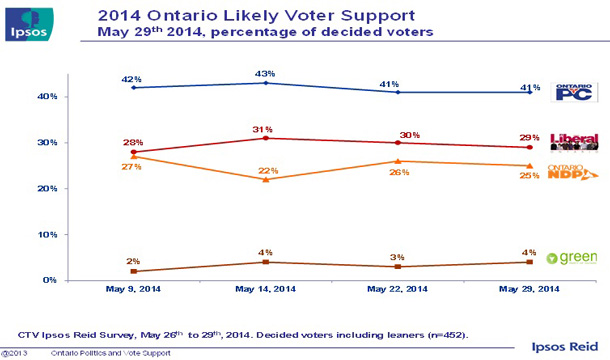
Polls Show Positives for All Parties
Toronto, ON – While the popular vote among decided voters in Ontario is tightening, with the Liberals rallying to within two points of the Progressive Conservatives overall, a closer look at who actually intends to show up and vote on Election Day tells a different story.
The Ipsos Reid Poll shows a strong voter turnout for the PCs even as the Liberals are climbing. For the New Democrats, the strong Northern Ontario numbers if they hold until voting day could bring new seats.
For the Liberals the surge and stronger growing vote shows positives too.
Likely turnout continues to suggest that Tory voters are poised to deliver big at the ballot box to the detriment of the incumbent governing Liberals, according to a new Ipsos Reid poll conducted on behalf of CTV News and CP24.
In short, while the Wynne Liberals appear closer to the Hudak PCs on the popular decided vote, until they motivate their supporters and galvanize a higher turnout at the ballot box they could be swamped by a PC surge that has remained adamant to turn up and vote from the outset of the campaign.
As for the Horwath’s NDP, their turnout vote is up from their 22.7% in the 2011 election to 25%.
To give more credence to this and the numbers that follow, those who say they will definitely turnout to vote is at 51%–almost exactly the provincial turnout rate in the 2011 campaign (49.2%). This number is then cross-tabulated among decided voters (the popular vote) to yield the adjusted and crucial turnout vote among likely voters.
The Popular Vote Shows A Tightening…
If the election were held tomorrow, the popular vote, as opposed to the turnout vote among likely voters, indicates that the Progressive Conservatives under Tim Hudak would receive 36% support among decided voters (up 1 point since last week), while the Liberals under Premier Kathleen Wynne have rallied at the expense of the NDP and now sit at 34% support (up 3 points), just two points behind the Tories. Andrea Horwath and her NDP have slipped to 23% (down 5 points), while other parties, including Mike Schreiner and the Green Party, would receive 7% of the vote. Nearly two in ten (17%) remain completely undecided, although only 6% of likely voters say the same.
Examining the overall popular vote within the key regions of Ontario shows that the Liberals have made gains in the 905 region surrounding Toronto, where the race is tight on the popular vote and getting out the vote, especially for the Liberals, will be a major factor if they are to do well:
- In the 905, the Liberals are ahead with 38% support, compared to 34% for the PCs, 21% for the NDP and 7% for other parties.
- In the 416, the Liberals (44%) have a solid advantage over the PCs (25%), NDP (22%), and other parties (9%).
- In Southwestern Ontario, the Tories (38%) hold a ten-point lead over the Liberals (28%) and the NDP (26%), while other parties trail (8%).
- In Central Ontario, the Tories (46%) lead the Liberals (34%), NDP (15%) and other parties (5%).
- In Eastern Ontario, the Tory (56%) lead over the Liberals (25%), NDP (14%) and others (4%) is robust.
- In Northern Ontario, the NDP (45%) maintain their lead over the Liberals (29%), PCs (22%) and other parties (5%).
But the Potential Turnout Vote at the Ballot Box is Where the Grits are in Serious Trouble…
While the Liberals have gained and the NDP have softened on the popular vote, the data reveal that it is mostly non-committed, non-voters who are switching back and forth between the two parties. The Tories continue to have the most motivated voters, while Liberal supporters are least motivated.
Among the 51% of Ontarians who say that ‘nothing short of an unforeseen emergency could stop me from getting to the voting booth and casting my vote’ on June 12, the Tories receive 41% of the vote (up 5 points compared to overall figures), while the Liberals sink to 29% (down 5 points). The NDP strengthen to 25% (up 2 points), while support for other parties, including the Green Party, softens to 4% (down 3 points). The vote numbers among likely voters have remained remarkably consistent over the last four weeks
In comparison to the 2011 election campaign, this would put the PCs at 41% compared to the 35.4% they received, the Liberals at 29% compared to the 37.7% they received and the NDP at 25% up from the 22.7% they received.
Further, PC voters are most likely to say that they are ‘absolutely certain’ (58%) that they will stick with the PCs and not change their mind, while only 47% of NDP voters and 38% of Liberal voters say the same.Interestingly, Liberal voters are also less likely (44%) to say they are paying ‘close attention’ to the Ontario Election campaign than NDP (55%) and PC (55%) voters are.
In short, as the Liberals gain in support in the popular vote, the proportion of their supporters who are likely to show up on Election Day and won’t change their mind beforehand decreases. The Liberal turnout vote, at this stage leading into the debate, is mostly anemic, unmotivated and disengaged.










